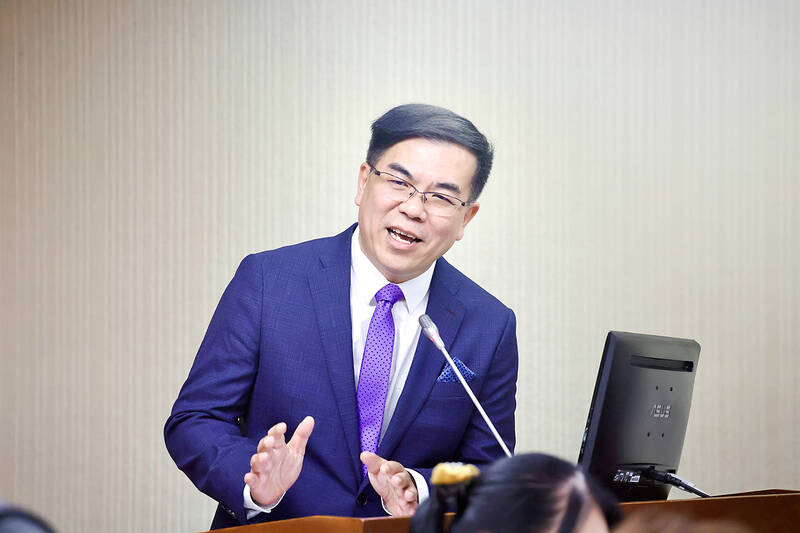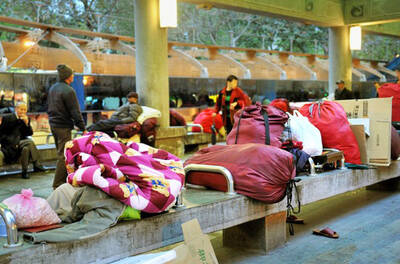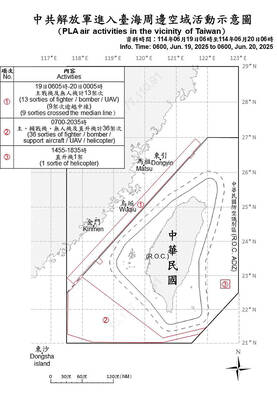Greenhouse gas emissions from the energy sector account for more than 90 percent of Taiwan’s total emissions and are challenging the government’s net zero goals, Minister of Environment Peng Chi-ming (彭啟明) said yesterday.
As it would be “very difficult” to achieve emissions reductions targets, the government needs to accelerate the development of green energy production if it hopes to meet its net zero emissions goal by 2030, Peng told a news conference in Taipei, where he announced the ministry’s latest report on greenhouse gas emissions.
In 2022, Taiwan recorded 285.97 million tonnes of greenhouse gas emissions and 264.13 million tonnes of net emissions (after removal of gases through land use changes and forestry) — a 4.07 percent decrease from 2021, and 1.77 percent drop compared with the base year, 2005, he said.

Photo: CNA
The energy sector produced 259.85 million tonnes of emissions in 2022, accounting for 90.87 percent of total emissions for that year, the report showed.
That was an increase of more than 10,000 tonnes compared with energy sector emissions in 2005, and also the largest annual increase in emissions for the sector, it showed.
As for other sectors in 2022, industrial processing and product usage accounted for 20.24 million tonnes of emission, or 7.08 percent; agriculture accounted for 3.18 million tonnes, or 1.11 percent; and waste management generated 2.7 million tonnes, or 0.94 percent.
A total of 21.83 million tonnes of the emissions were removed through land use, land use changes and forestry, accounting for 7.64 percent of total emissions in 2022.
“During the COVID-19 pandemic, Taiwan’s economy grew, but its carbon emissions were lower than those of other countries,” Peng said. “That was a positive trend, but we still have much to do in the drive toward net zero emissions.”
Although there is currently no adequate plan in place for the nation’s energy transition, as the environment minister, he would uphold Article 23 of the Basic Environment Act (環境基本法), which states that “the government must formulate a plan to progressively achieve the goal of a non-nuclear homeland,” he said.
A public majority consensus would be needed to continue using nuclear power, but finding a solution for nuclear waste disposal remains a challenge, he said.
“For now, the development of green energy solutions needs to be accelerated. If new technologies emerge, we need to adjust to those developments,” he said.
The government’s current emissions-reduction plan calls for a 10 percent reduction compared with the base year by next year, Peng said, adding that it would be difficult to achieve.

A year-long renovation of Taipei’s Bangka Park (艋舺公園) began yesterday, as city workers fenced off the site and cleared out belongings left by homeless residents who had been living there. Despite protests from displaced residents, a city official defended the government’s relocation efforts, saying transitional housing has been offered. The renovation of the park in Taipei’s Wanhua District (萬華), near Longshan Temple (龍山寺), began at 9am yesterday, as about 20 homeless people packed their belongings and left after being asked to move by city personnel. Among them was a 90-year-old woman surnamed Wang (王), who last week said that she had no plans

TO BE APPEALED: The environment ministry said coal reduction goals had to be reached within two months, which was against the principle of legitimate expectation The Taipei High Administrative Court on Thursday ruled in favor of the Taichung Environmental Protection Bureau in its administrative litigation against the Ministry of Environment for the rescission of a NT$18 million fine (US$609,570) imposed by the bureau on the Taichung Power Plant in 2019 for alleged excess coal power generation. The bureau in November 2019 revised what it said was a “slip of the pen” in the text of the operating permit granted to the plant — which is run by Taiwan Power Co (Taipower) — in October 2017. The permit originally read: “reduce coal use by 40 percent from Jan.

China might accelerate its strategic actions toward Taiwan, the South China Sea and across the first island chain, after the US officially entered a military conflict with Iran, as Beijing would perceive Washington as incapable of fighting a two-front war, a military expert said yesterday. The US’ ongoing conflict with Iran is not merely an act of retaliation or a “delaying tactic,” but a strategic military campaign aimed at dismantling Tehran’s nuclear capabilities and reshaping the regional order in the Middle East, said National Defense University distinguished adjunct lecturer Holmes Liao (廖宏祥), former McDonnell Douglas Aerospace representative in Taiwan. If

‘SPEY’ REACTION: Beijing said its Eastern Theater Command ‘organized troops to monitor and guard the entire process’ of a Taiwan Strait transit China sent 74 warplanes toward Taiwan between late Thursday and early yesterday, 61 of which crossed the median line in the Taiwan Strait. It was not clear why so many planes were scrambled, said the Ministry of National Defense, which tabulated the flights. The aircraft were sent in two separate tranches, the ministry said. The Ministry of Foreign Affairs on Thursday “confirmed and welcomed” a transit by the British Royal Navy’s HMS Spey, a River-class offshore patrol vessel, through the Taiwan Strait a day earlier. The ship’s transit “once again [reaffirmed the Strait’s] status as international waters,” the foreign ministry said. “Such transits by